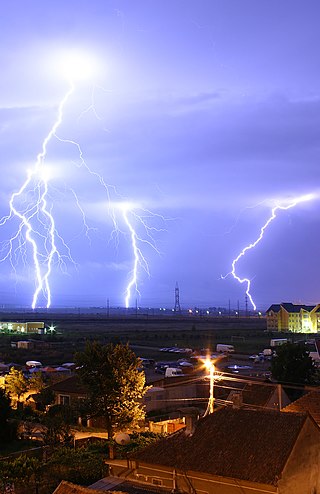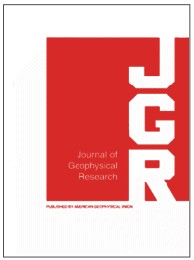Related Research Articles

Lightning is a natural phenomenon formed by electrostatic discharges through the atmosphere between two electrically charged regions, either both in the atmosphere or with one in the atmosphere and on the ground, temporarily neutralizing these in a near-instantaneous release of an average of one gigajoule of energy. This discharge may produce a wide range of electromagnetic radiation, from heat created by the rapid movement of electrons, to brilliant flashes of visible light in the form of black-body radiation. Lightning causes thunder, a sound from the shock wave which develops as gases in the vicinity of the discharge experience a sudden increase in pressure. Lightning occurs commonly during thunderstorms as well as other types of energetic weather systems, but volcanic lightning can also occur during volcanic eruptions. Lightning is an atmospheric electrical phenomenon and contributes to the global atmospheric electrical circuit.

La Niña is an oceanic and atmospheric phenomenon that is the colder counterpart of El Niño, as part of the broader El Niño–Southern Oscillation (ENSO) climate pattern. The name La Niña originates from Spanish for "the girl", by analogy to El Niño, meaning "the boy". In the past, it was also called an anti-El Niño and El Viejo, meaning "the old man."

Water vapor, water vapour or aqueous vapor is the gaseous phase of water. It is one state of water within the hydrosphere. Water vapor can be produced from the evaporation or boiling of liquid water or from the sublimation of ice. Water vapor is transparent, like most constituents of the atmosphere. Under typical atmospheric conditions, water vapor is continuously generated by evaporation and removed by condensation. It is less dense than most of the other constituents of air and triggers convection currents that can lead to clouds and fog.

The tropopause is the atmospheric boundary that demarcates the troposphere from the stratosphere, which are the lowest two of the five layers of the atmosphere of Earth. The tropopause is a thermodynamic gradient-stratification layer, that marks the end of the troposphere, and is approximately 17 kilometres (11 mi) above the equatorial regions, and approximately 9 kilometres (5.6 mi) above the polar regions.

The Schumann resonances (SR) are a set of spectrum peaks in the extremely low frequency portion of the Earth's electromagnetic field spectrum. Schumann resonances are global electromagnetic resonances, generated and excited by lightning discharges in the cavity formed by the Earth's surface and the ionosphere.
John Raymond Christy is a climate scientist at the University of Alabama in Huntsville (UAH) whose chief interests are satellite remote sensing of global climate and global climate change. He is best known, jointly with Roy Spencer, for the first successful development of a satellite temperature record.

Atmospheric electricity describes the electrical charges in the Earth's atmosphere. The movement of charge between the Earth's surface, the atmosphere, and the ionosphere is known as the global atmospheric electrical circuit. Atmospheric electricity is an interdisciplinary topic with a long history, involving concepts from electrostatics, atmospheric physics, meteorology and Earth science.

The Journal of Geophysical Research is a peer-reviewed scientific journal. It is the flagship journal of the American Geophysical Union. It contains original research on the physical, chemical, and biological processes that contribute to the understanding of the Earth, Sun, and Solar System. It has seven sections: A, B, C (Oceans), D (Atmospheres), E (Planets), F, and G (Biogeosciences). All current and back issues are available online for subscribers.

The atmosphere of Venus is primarily of supercritical carbon dioxide and is much denser and hotter than that of Earth. The temperature at the surface is 740 K, and the pressure is 93 bar (1,350 psi), roughly the pressure found 900 m (3,000 ft) underwater on Earth. The Venusian atmosphere supports opaque clouds of sulfuric acid, making optical Earth-based and orbital observation of the surface impossible. Information about the topography has been obtained exclusively by radar imaging. Aside from carbon dioxide, the other main component is nitrogen. Other chemical compounds are present only in trace amounts.

The cumulonimbus flammagenitus cloud (CbFg), also known as the pyrocumulonimbus cloud, is a type of cumulonimbus cloud that forms above a source of heat, such as a wildfire or volcanic eruption, and may sometimes even extinguish the fire that formed it. It is the most extreme manifestation of a flammagenitus cloud. According to the American Meteorological Society’s Glossary of Meteorology, a flammagenitus is "a cumulus cloud formed by a rising thermal from a fire, or enhanced by buoyant plume emissions from an industrial combustion process."

A global atmospheric electrical circuit is the continuous movement of atmospheric charge carriers, such as ions, between an upper conductive layer and surface. The global circuit concept is closely related to atmospheric electricity, but not all atmospheres necessarily have a global electric circuit. The basic concept of a global circuit is that through the balance of thunderstorms and fair weather, the atmosphere is subject to a continual and substantial electrical current.

Volcanic lightning is an electrical discharge caused by a volcanic eruption rather than from an ordinary thunderstorm. Volcanic lightning arises from colliding, fragmenting particles of volcanic ash, which generate static electricity within the volcanic plume, leading to the name dirty thunderstorm. Moist convection and ice formation also drive the eruption plume dynamics and can trigger volcanic lightning. Unlike ordinary thunderstorms, volcanic lightning can also occur before any ice crystals have formed in the ash cloud.

Plasma is one of four fundamental states of matter, characterized by the presence of a significant portion of charged particles in any combination of ions or electrons. It is the most abundant form of ordinary matter in the universe, mostly in stars, but also dominating the rarefied intracluster medium and intergalactic medium. Plasma can be artificially generated by heating a neutral gas or subjecting it to a strong electromagnetic field.
Paleolightning refers to the remnants of ancient lightning activity studied in fields such as historical geology, geoarchaeology, and fulminology. Paleolightning provides tangible evidence for the study lightning activity in Earth's past and the roles lightning may have played in Earth's history. Some studies have speculated that lightning activity played a crucial role in the development of not only Earth's early atmosphere but also early life. Lightning, a non-biological process, has been found to produce biologically useful material through the oxidation and reduction of inorganic matter. Research on the impact of lightning on Earth's atmosphere continues today, especially with regard to feedback mechanisms of lightning-produced nitrate compounds on atmospheric composition and global average temperatures.

STEVE is an atmospheric optical phenomenon that appears as a purple and green light ribbon in the sky, named in late 2016 by aurora watchers from Alberta, Canada. According to analysis of satellite data from the European Space Agency's Swarm mission, the phenomenon is caused by a 25 km (16 mi) wide ribbon of hot plasma at an altitude of 450 km (280 mi), with a temperature of 3,000 °C and flowing at a speed of 6 km/s (3.7 mi/s). The phenomenon is not rare, but had not been investigated and described scientifically prior to that time.

Axel Timmermann is a German climate physicist and oceanographer with an interest in climate dynamics, human migration, dynamical systems' analysis, ice-sheet modeling and sea level. He served a co-author of the IPCC Third Assessment Report and a lead author of IPCC Fifth Assessment Report. His research has been cited over 18,000 times and has an h-index of 70 and i10-index of 161. In 2017, he became a Distinguished Professor at Pusan National University and the founding Director of the Institute for Basic Science Center for Climate Physics. In December 2018, the Center began to utilize a 1.43-petaflop Cray XC50 supercomputer, named Aleph, for climate physics research.
Arlene M. Fiore is an atmospheric chemist whose research focuses on issues surrounding air quality and climate change.
Linda Opal Mearns is a geographer and climate scientist specializing in climate change assessment science. Mearns is a senior scientist at the National Center for Atmospheric Research (NCAR). Mearns is the director of NCAR's Weather and Climate Impacts Assessment Science Program (WCIASP) and head of the Regional Integrated Sciences Collective (RISC). Mearns is a lead principal investigator for the North American Regional Climate Change Program (NARCCAP).
Mary Hudson is the Eleanor and Kelvin Smith Distinguished Professor of Physics at Dartmouth College. She is known for her research on the weather patterns that occur due to solar eruptions. She was elected a fellow of the American Geophysical Union in 1984.
Everly John "Jack" Workman was an American atmospheric physicist, known for the Workman-Reynolds effect, discovered in 1950 by him and his colleague Stephen E. Reynolds, State Engineer of New Mexico from 1955 to 1990.
References
- Banko, A. G., J. Karfunkel, W. Hadrian, and F. Noack. 2002. "Brasilianische Blitzquarze - Die ungewöhnlichen Zeugen eines alltäglichen Naturschauspiels" ("Brazilian Lightning-quartz - The Unusual Witnesses of an Everyday Nature Show"), Aufschluss , no. Jan./Feb., 53:25-36. Heidelberg.
- Karfunkel, J., J. Addad, A. G. Banko, W. Hadrian, and D. B. Hoover. 2001. "Electromechanical disintegration - an important weathering process", Z Geomorphol N F, no. 3, 45:345-357. Berlin-Stuttgart.
- Karfunkel, J., J. Addad, A. G. Banko, W. Hadrian, F. Noack, and D. B. Hoover. 1999. "Transição de quartzo-alfa para quartzo-beta em conseqüência de descargas atmosféricas: exemplo de quartzo gemológico em depósitos coluvionares" ("Transition of Quartz-alpha into Quartz-beta as a Consequence of Atmospheric Discharge"), Revista da Escola de Minas de Ouro Preto, no. 3, 52:166-171. Ouro Preto.
- Karfunkel, J., M. L. S. C. Chaves, A. G. Banko, W. Hadrian, F. Noack, and J. Schönau. 1998. "Vom Blitz getroffen: Quarze aus Brasilien" ("Struck by Lightning: Quartz from Brazil"), Mineralien Welt (Minerals World), no. 5, 9:54-60.
- Karfunkel, J., A. G. Banko, W. Hadrian, D. B. Hoover, J. Addad, M. S. Martins, R. Scholz, and B. Peregovich. 2000. Die Elektromechanische Zersetzung am Beispiel des Espinhaço-Gebirges, Zentral-Ost Brasilien" ("The Electromechanical Transition in an Example of Espinhaço Mountains, Central-East Brazil" ), XVI Geowissenschaftliches Lateinamerika Kolloquium (16th Geological Latin-American Colloquium), Stuttgart, 2000.
- Karfunkel, J., A. G. Banko, J. Addad, M. S. Dantas, M. Pimenta, M. Pinheiro, K. Krambrock, W. Hadrian, and D. B. Hoover. 2000. "High P/T silica polymorphs due to atmospheric discharges", General Symposium 8-6/ Mineralogy, Physics and Chemistry of Minerals, XXXI International Geological Congress, Rio de Janeiro, 2000, M57-M57.
- Karfunkel, J., M. V. B. Pinheiro, K. Krambrock, F. S. Lameiras, A. G. Banko, and W. Hadrian. 2000. "Temperature-time bleaching reaction in smoky quartz: nature and experiment", General Symp. 6-8/ Mineralogy, Physics and Chemistry of Minerals, XXXI International Geological Congress, Rio de Janeiro, 2000.
- Karfunkel, J., J. Addad, A. G. Banko, B. Peregovich, and D. B. Hoover. 1999. "Fracturing and disintegration of rocks due to atmospheric discharges", AGU-1999 Fall Meeting, American Geophysical Union - 1999 Fall Meeting, San Francisco, 1999, 79:32-32.
- Karfunkel, J., A. G. Banko, and D. B. Hoover. 1998. "A contribution to physical weathering", AGU-1998 Fall Meeting, American Geophysical Union - 1998 Fall Meeting, San Francisco, 1998, 79:F126-F126.
- Karfunkel, J., A. G. Banko, M. L. S. C. Chaves, and J. Addad. 1998. "Shock deformation of rocks due to lightning discharges", AGU-1998 Spring Meeting, American Geophysical Union - 1998 Spring Meeting, San Francisco, 1998, 79:32-32.
- Karfunkel, J., M. L. S. C. Chaves, A. G. Banko, W. Hadrian, F. Noack, and J. Schönau. 1998. "The effects of electrical discharge energy on quartz and its importance as a geological process", Simpósio 14 - Mineralogia e Gemologia, XL Congresso Brasileiro De Geologia - EXPOGEO 98, Belo Horizonte, 1998, 297-297 Belo Horizonte: SBG-MG.
- Karfunkel, J., M. L. S. C. Chaves, and A. G. Banko. 1996. "Natural shock-induced deformation: neither volcanic nor of meteorite impact origin", American Geophysical Union - 1996, San Francisco, 1996, 77:89-89.